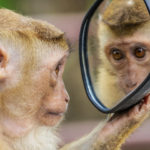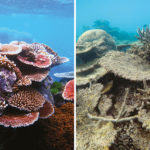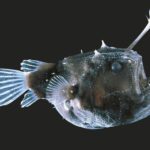Do you remember any of the history lessons you had in primary school? Does the word Mesopotamia ring a bell? I’m sure it does. All of us were taught that’s where humans first started farming around 15.000 years ago, give or take a few thousand years. After roaming the earth for millions of years as hunter-gatherers, our ancestors were now able to grow their food and provide for their family. People could stay in one place, giving up a lifestyle of nomading. Settlements became villages, turned into the first cities and civilisation as we know it was born.

Humans were not the first ones to “invent” farming though. Someone has already been doing it for a few million years. Meet the protagonist of today’s story, the damselfish. Damselfish – there are about 300 species of them – come in a variety of colours and shapes and a few of them have some very interesting behaviour.

Like a lot of other fishes, damselfish are grazers that feed on algae. Algae are primary producers, which means they convert inorganic matter into organic matter. Algae do this converting CO2 and water into sugars, using sunlight, a process called photosynthesis. It’s those sugars the damselfish have to eat to get their energy and stay alive. The waste product of photosynthesis is oxygen. Yay for algae!

Fun fact, plants, including algae, make their own food through primary production, which makes them autotrophs. Animals on the other hand, have never learned this trick and have to get their energy elsewhere, grazing or hunting. They, including us, are heterotrophs. That’s the main difference between plants and animals. Fun, right? 😆
Back to the algae. It turns out not all algae are equally easy to digest. On top of that, damselfish have a weak stomach. To prevent tummy ache or excessive gas – a damselfish doesn’t wan’t to turn into a ballon and start floating to the surface -, they prefer to only eat the types of algae that are easily digested . They’ve found an ingenious way to do that. Instead of swimming around and look for their favourite food, they make their own little farm and cultivate it instead! They choose a spot to their liking, somewhere rocky with a little bit of shelter and with some algae present already. They have to be a bit picky, because this will probably be their home for the rest of their life. Then they get to work.
First, they start pulling out all the algae they don’t like, and throw them out of their little territory. Without any competition, the tasty algae will now grow way more abundantly. Then, the damselfish will start protecting their crop like mad dogs. Any diver will know what I’m talking about. Damselfish will attack cameras, nibble at your fingers or start bumping into your mask. They will attack and successfully scare off other fish many times their own size. And there’s more. Scientists found that to conserve energy, they are selective in which animals to chase away and which not. It seems that they only go after other grazers that might eat their crop, and other grazers or carnivores are left alone.
To see a damselfish in action, take a look at the video below. Feisty little things!








